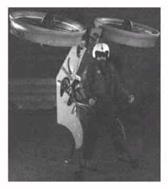Returning to Flying’s Roots
There’s a little company in California called Millennium Jet, and if Icarus could have gotten his hands on what they’re making, he would have made it from Crete to Greece without hitting the drink before he got there.
Millennium Jet makes the SoloTrek XFV, or Exo – Skeletor Flying Vehicle. It’s a oneperson flying machine that looks like a cross between one of Leonardo da Vinci’s helicopters and the jet-powered backpack that some daredevils flew around in during the 1960s and 1970s.
|
The SoloTrek XFV could bring pilots closer than ever to the ease and maneuverability of bird flight. (Millennium Jet) |
Here’s how the XFV works: A pilot straps into it and fires up two shrouded fans above his head. Using hand grips, the pilot controls the speed and tilt of the fans to take off and maneuver above the ground. The XFV can stay in the air for 90 minutes and fly at 80 miles an hour.
The technology, which appears outlandish on first glance, has attracted NASA’s interest, and it’s sure to be one of the greatest toys for the wealthy since the DeLorean—and will probably cost about the same.
The XFV, Paul MacCready’s human-powered flying machines, and Burt Rutan’s visionary designs are all shades of a dream to fly higher, or faster, or less encumbered. Like the flyers of myth and the dreamers of antiquity, men and women with an itch to fly are still searching for their own wings.
The Least You Need to Know
>- Human-powered flight continues to improve, thanks to research around the world.
V Burt Rutan’s desert uSkunk Works" is inventing new rules for the way airplanes are designed.
^ Hyper-X and other hypersonic planes could pave the way for super-fast passenger flights.
^ Rival airline manufacturers Boeing and Airbus are trying to outbuild each other, and at feast on the drawing board. Airbus has the advantage.
^ Technology is close to enabling men and women to fly as high as, if not as gracefully as, the birds.












